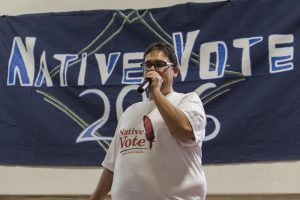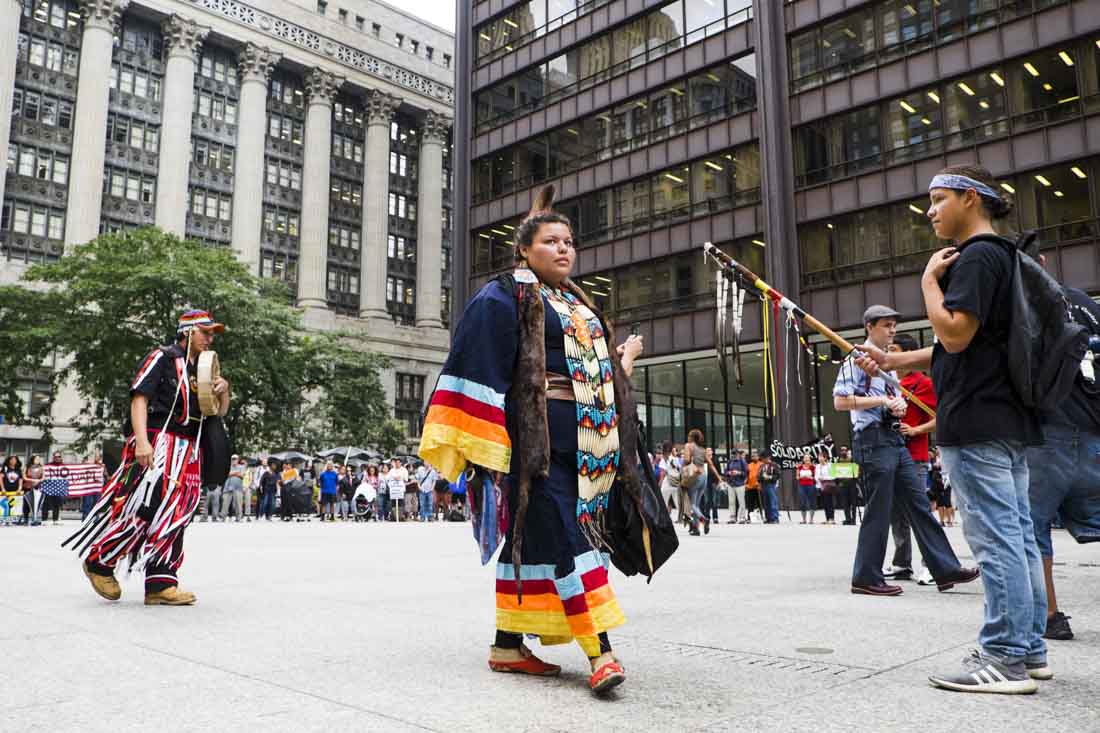By Pat Nabong
[Package of Standing Rock and the Dakota Access Pipeline stories here]
In the run-down American Indian Center, fewer than 20 Native Americans are gathered to discuss issues that are important to them in this year’s election.
Susan Power, one of the founding members of the center, looks around the room. She bellows, “Where are all the Indians? Why aren’t they here?”
The room is silent.
David Bender, a community organizer, pipes up and reminds the handful of people who have gathered under hundreds of tribal nations’ flags that although they are small in number, their votes matter.

Native Americans and Alaska Natives make up less than one percent of the U.S. voting population, according to 2016 census data. In Illinois, they make up even less – 0.2 percent. Historically speaking, Native Americans have one of the lowest voter turnout rates among all ethnic groups in the U.S., according to a research by political participation expert Tova Wang.
But with the election imminent, Native Americans’ struggle for visibility continues.
“There are so many groups of people, they outnumber us right away,” said Power. “And so it behooves us to really learn and keep together and remind each other that at one time, we were all the big, important nations here.”
Although the percentage of Native Americans is smaller than other ethnic groups, there is a lot at stake this election, according to Bender.
“I’ve been hearing about people who weren’t politically inclined before are becoming politically inclined now,” said Bender. “I think it has a lot to do with the connection with the current events that are happening right now.” Bender is referring to the controversial $3.8 billion Dakota Access Pipeline that is slated to carry oil from North Dakota to Illinois.
Fighting for the environment
Since April, the Standing Rock Sioux Tribe has been camping out in North Dakota, fighting the construction of a pipeline that threatens the tribe’s sacred burial sites and water source. This has turned into an international issue that has brought Native Americans to the forefront of yet another environmental battle. Over 300 Native American tribes and a number of indigenous groups from other countries have stood in solidarity with the movement, now known as NoDAPL.
“It’s time to wake up at this NoDAPL,” said Reginald Sawyer, president of Chicago Two–Spirit Society, an organization that supports Native American LGBTs. “We don’t need no oil spill because if those pipes bust and the oil spills in our water, that’s poisonous. That’s not only going to kill our four-legged brothers and sisters and our winged ones, that’s also hurting us as well…So get out there, make your voice be heard.”

Although the NoDAPL movement has been getting a lot of attention, it is not just a pipeline that is on the minds of Native Americans in this election. Environmental issues in general are at the forefront.
“With this global warming thing going on, environmental justice is one of our biggest fights that we’re doing here,” said Sarina DiMaso, of the Chiricahua Apache Nation and an organizer at the American Indian Center.
Native Americans, whose culture and spirituality are deeply rooted in the environment, have a long history of environmental struggles on their lands, such as the Keystone XL pipeline and uranium excavation within the Navajo Nation.
But with the ongoing fight against the Dakota Access Pipeline and the proposed open–pit mine that the Menominee Indian Tribe says will disrupt sacred tribal lands, the issue of environmental injustice seems timeless.
“We’ve had three presidential debates and the issue of this place being [in] a state of ongoing occupation of indigenous peoples’ lands never came up,” said Doug Kiel of the Oneida Nation in Wisconsin and assistant professor in Northwestern University’s Department of History. “And I think for a lot of people, that’s what’s exciting about this [NoDAPL] movement— [it] is that people are actually paying attention to it and hopefully, from there actually going to be paying attention to a wide variety of issues that affect Native people.”
Three 2016 Presidential #Debates and we Native Americans who have lived here longer than anybody…
WERE NOT TALKED ABOUT ONE SINGLE TIME.
— A Merciless Indian Savage (@YakamaRaised) October 20, 2016
Ever feel like #AmericasWarOnAmerica in #northdakota should've been addressed at a #PresidentialDebate? No? Just me? #NoDAPL #MniWiconi
— WeBeAntosovi (@LeyMiLia) November 4, 2016
https://twitter.com/imnotscotwalker/status/785309629865598976
Days after the third presidential debate, Hillary Clinton’s campaign released a statement regarding the NoDAPL movement:
Secretary Clinton has been clear that she thinks all voices should be heard and all views considered in federal infrastructure projects. Now, all of the parties involved—including the federal government, the pipeline company and contractors, the state of North Dakota, and the tribes—need to find a path forward that serves the broadest public interest. As that happens, it’s important that on the ground in North Dakota, everyone respects demonstrators’ rights to protest peacefully, and workers’ rights to do their jobs safely.
“That [statement] kind of shows that this isn’t really something that we can trust her with either,” said Forrest Bruce, former co-president of Native American and Indigenous Student Alliance at Northwestern University. “I don’t think our issues are really represented on the ballot like they should be.”
Other concerns
Other than environmental issues, Kiel and Bender think sovereignty is another salient issue surrounding this election.
“Seeing treaties honored—it’s another issue that Native people are always concerned about. Is our sovereignty going to be protected?” asked Bender.
To Kiel, it is important that the next president recognizes “the ability for tribal governments to be able to actually have authority over their own lands and jurisdiction over the people within them.”
Some are also concerned about poverty and homelessness in the Native American LGBT community, said Sawyer.
Statistics show that whoever wins the presidential seat has a lot to address among Native Americans. From 2007 to 2011, American Indians and Alaska Natives had the highest poverty rate, according to the U.S. Census Bureau. Compared to all other races, Native Americans are 2.5 times more likely to be sexually assaulted, according to the U.S. Department of Justice. American Indians and Alaska Natives have higher incidences of illnesses such as diabetes. They also have highest youth suicide rate.
Even voting is an issue for Native Americans. “People feel like their vote doesn’t matter,” said Bender.
Although there has been an increase in voter turnout in some communities, voter turnout among Native Americans has been low compared to other ethnic groups, according to Wang. This is because of a number of reasons, including distrust of federal government, desire for tribal sovereignty, voter discrimination and inaccessibility to polling places, wrote Wang.
Back at the American Indian Center, Bender looks at the empty seats in the room. He tells Power that although there are fewer than 20 of them gathered at the American Indian Center, many of them are at rallies, protesting various Native American issues. “I think people are making connections that they weren’t making before, so I’m optimistic that more Native people are going to be voting in this election,” said Bender.
To people like Bender and Bruce, voting is only the first step to visibility.
“It’s important to go out and really make your voice heard,” said Bruce. “But I think it’s important to try to work outside of the system and really try to disrupt politics and kind of like dismantle them and restructure them; rebuild them so that they can serve our people and what we need.”
Pat Nabong/MEDILL
Save
Save


